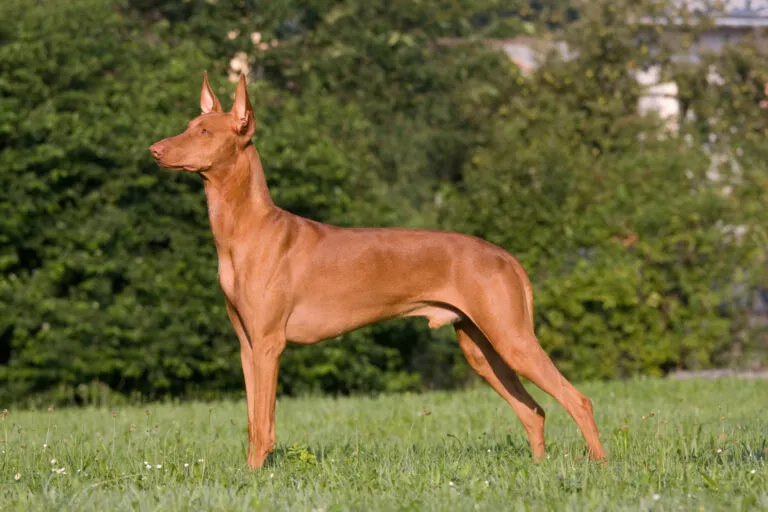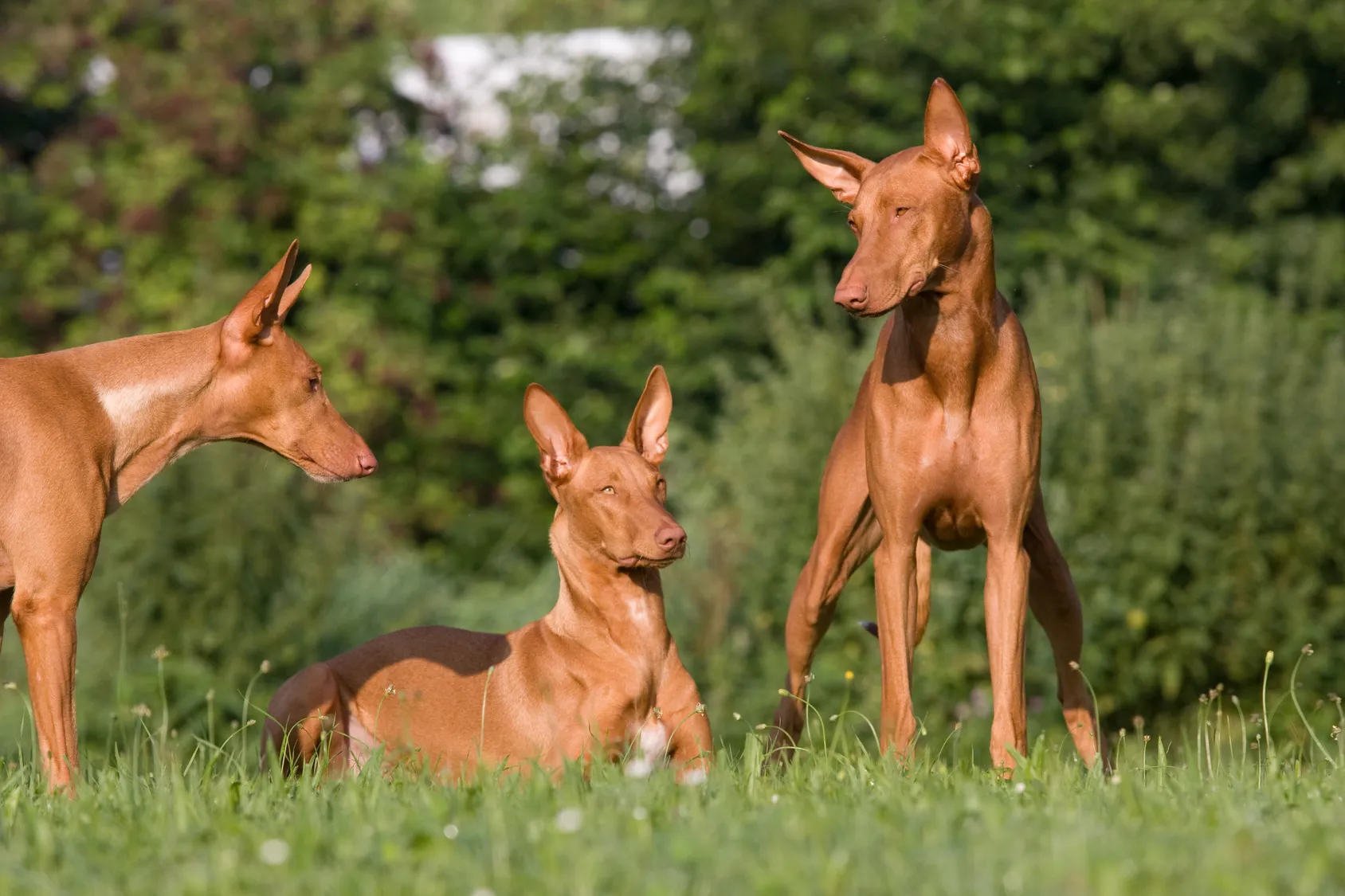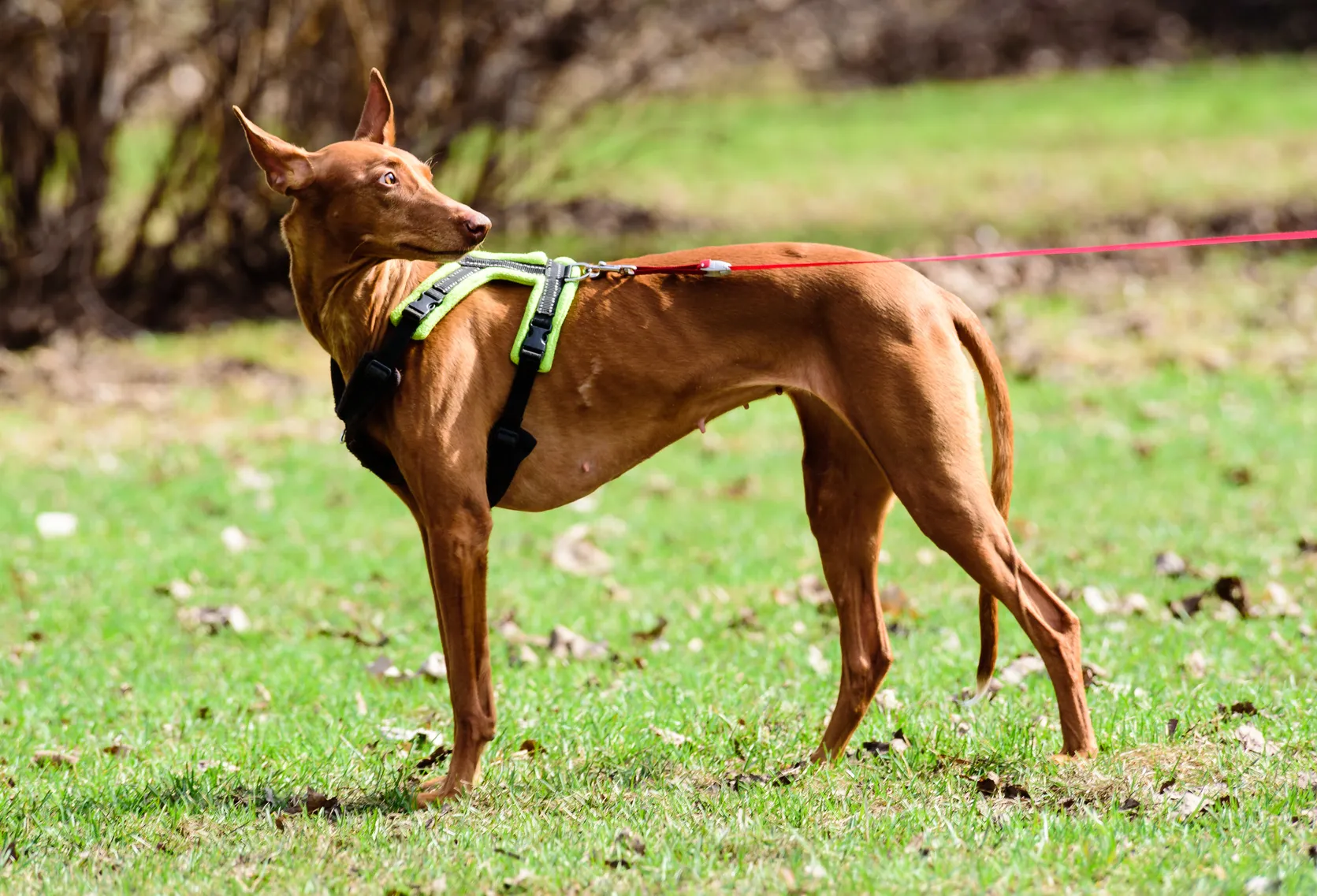Beagle
The Beagle's short legs can be deceiving – this medium-sized dog keeps you on your toes and is always full of surprises! This friendly breed is active, fearless and extremely clever.
Not just fans of ancient Egypt are fascinated by these striking dogs: the Pharaoh Hound stands out thanks to its elegant appearance and friendly nature, though is only suitable for experienced dog owners who can give it plenty of exercise.

© lenkadan / stock.adobe.com
The Pharaoh Hound’s name is inspired by its striking silhouette, which resembles depictions of the Egyptian god Anubis, with whom it shares its large upright ears, long neck and slim physique like that of a greyhound. Males reach a shoulder height of up to 63cm and females up to 61cm. The fur is rusty brown and shiny. White markings are allowed on some body parts (paws, blaze, chest) according to the standard, whilst a white tip of the tail is expressly desired. The Pharaoh Hound doesn’t have any black skin pigment, which leads to the nose, eyelids and inner ears being flesh-coloured. Its long tail reaches beneath its ankles.
One theory on the origin of the Pharaoh Hound claims that its ancestors were brought by the Phoenicians to Malta during ancient times, where it has served humans as a hunting dog for centuries. This would mean that they originated from Tesem dogs, which physically resembled depictions of Anubis, the ancient Egyptian god of the dead. Skeletal remains of similar dogs in Egypt are around 5,000 years in age and attest to an incredibly long history. However, this theory is not certain: objectors oppose it, for instance, claiming that there is only proof of these dogs being in Malta from the Middle Ages. Nowadays, it’s considered more probable that the Pharaoh Hound developed from pariah dogs from the regions in question, similar to several Podenco breeds. This also applies to the Cirneco dell’ Etina, a breed originating from the neighbouring island of Sicily confusingly similar to the Pharaoh Hound. Almost the only difference between the two breeds is their size. Proponents of this theory assume that this type of dog developed at the same time due to similar environmental conditions. What’s certain is that the Pharaoh Hound has been a hunting companion to the people of Malta for years and still carries out this role to this day, since it is a versatile hunter that hunts mainly on sight. Things can get rather noisy: the Pharaoh Hound barks in its typical manner to draw the attention of its fellow canines towards prey. It also hunts with a “soft mouth”, meaning that it can bring prey to the hunters whilst it is still alive. Although the FCI lists the Pharaoh Hound as a dog of Maltese origin, Britain has the patronage of the breed. This is where the Pharaoh Hound has been bred in a targeted manner since the 1960s, with the British Kennel listing the breed since 1974.
The name “Pharaoh Hound” isn’t always clear. This is because all Podenco-type dogs were casually known as Pharaoh Hounds up until 1977, when the FCI recognised the Maltese breed, which led to just this one being known as the “Pharaoh Hound” – at least in theory. In Malta itself, however, the breed was exclusively known under the name Kelb tal-Fenek before British breeders showed an interest in these elegant dogs. This name is still used to this day and roughly translates to something like “rabbit dog”, which indicates their purpose of hunting rabbits. In Malta in particular, more and more fans of these dogs are campaigning for the breed to once again be listed under its original name Kelb tal-Fenek.
 © lenkadan / stock.adobe.com
© lenkadan / stock.adobe.com
Despite its proud appearance, the Pharaoh Hound can be affectionate, though hunting always remains in its blood. This means that it is almost impossible for it to run off its lead, which in turn leads to many Pharaoh Hounds kept as companion dogs not being properly stimulated and becoming restless. However, if the Pharaoh Hound can let off steam as needed, it is a calm and all-round charming dog that loves playing and cuddling with its human family, though it always maintains a certain degree of independence. It is alert and rather distanced towards strangers. The breed generally gets on great with other dogs and can be kept in a pack without problems. Be warned though that some Pharaoh Hounds love barking and use it to show their emotions, as well as unusual occurrences.
Empathetic and consistent training proves successful with Pharaoh Hounds. Empathetic refers to the fact that the breed will always be headstrong, which should be respected during obedience training. Some experience with dogs is needed to walk the thin line between tolerance and severity in order to cope with the Pharaoh Hound’s special character. If you are too strict, these proud dogs will retreat and be unreceptive to training. If you aren’t clear and consistent in your rules, they will run rings around you after just a few weeks. Even if you have plenty of expertise relating to dogs and are very optimistic, you can’t assume that you will always be able to retrieve every Pharaoh Hound – they are, after all, passionate hunters. Nevertheless, you should practise retrieval when they are still puppies. Likewise, you should keep their love of barking under control. Always bear in mind that only stimulated Pharaoh Hounds will fulfil in any way the requirements to show obedience. Even for this sociable breed, puppy play sessions and attending a dog school, ideally one with experience handling hunting dogs, is a good supplement to your private training schedule.
If you buy a Pharaoh Hound from a responsible breeder, you will probably end up with a dog free from genetic diseases. In principle, the Pharaoh Hound is a robust breed with no known genetic diseases. However, serious breeders will have parent animals examined before they are deployed for breeding to check the health of the hips, knees and eyes and will gladly show you the results. A responsible breeder who works with a pedigree certificate can also use their expertise to minimise the danger of a high ratio of inbreeding, since the gene pool of this rare breed is very small. This breed may have an intolerance to certain anaesthetics – discuss this with your vet before any operations. Due to its origins in warm countries, the Pharaoh Hound is also very sensitive to the cold – especially the ears. Healthy Pharaoh Hounds can reach 12 to 14 years of age.
The Pharaoh Hound is very good at utilising food and doesn’t need any particularly energy-rich food in relation to its activity level, though it does often show an above-average appetite. Make sure protein consumption is balanced, ideally with a high proportion of meat in the food. You can recognise this by meat being first on the ingredients list, which should apply with both wet and dry food. In contrast, grain has no place in a high-quality food. Thanks to the short fur, you can soon recognise if your sporty dog has put on extra weight. Take action against this early on by reducing portion sizes or by giving your dog more exercise. A special diet food is generally not necessary. After meals, always give your dog time to rest to prevent the dangers of stomach twist. Ideally only feed your dog after you have gone on walks, trips or done any sporting activity. Also ration the amount of treats, which should be calculated as part of the daily calorie allowance. Always choose healthy sugar-free treats, such as dental care snacks or dried chunks of meat for dogs. In any case, you can reward your dog too by stroking it or playing games. Dried chew products for dogs stimulate the Pharaoh Hound’s natural urge to chew. Always make sure that your companion has enough drinking water.
The Pharaoh Hound’s short fur is very low-maintenance. Occasionally grooming the fur with a massage glove for dogs removes loose hairs and also strengthens the bond between you and your dog. You can usually brush out dirt once it is dry. If not, dampen a flannel and clean your companion with water. Regularly check the ears for dirt and if necessary use a suitable ear cleanser for dogs. You should also take a look at the claws from time to time: if they get too long, you should give them a trim with claw clippers to prevent potential injury through them getting caught.
 © alexei_tm / stock.adobe.com
© alexei_tm / stock.adobe.com
These dogs enjoy running and need the exercise too! You should allow them to get a great deal of exercise. All their senses are heightened when out and about – after all, some tasty prey may cross their path. Their strong hunting instinct means that they are generally not dependable when it comes to retrieval – you should consider alternatives to straightforward walks. Greyhound racing is ideal for this breed, especially what is known as coursing, which allows it to really let off steam. Otherwise, it can accompany you jogging – provided it is on its lead. Full-on dog sport is of course only possible with adult dogs following adapted training that gradually increases in intensity. The Pharaoh Hound also enjoys agility or games that stimulate its hunting instinct. However, make sure with all activity that your Pharaoh Hound can enjoy quiet time with you too so that it doesn’t turn into a constantly hyper companion.
Most dog lovers will be aware just by looking at this dynamic breed that sporty Pharaoh Hounds are only a good fit for sporty people. Ideally, they will have a large and securely fenced property – don’t underestimate the jumping ability of this breed – in which the Pharaoh Hound can frolic around. This can be in a pack too, which makes it even easier to tire out the Pharaoh Hound through fun and games. However, this is merely a welcome addition to the daily time you should be out and about together or providing mental stimulation – outdoor access alone isn’t enough. Pharaoh Hounds enjoy playing with children and can be wonderful companions, though it is better if the child is already of school age. Cats, rabbits or any potential “prey” shouldn’t live in your household – even if they are well protected, the mere presence of an innate enemy would be a constant source of stress for both animals. Although keeping a Pharaoh Hound in a ground-floor property with a fenced garden would in theory be possible, the breed’s love of barking often makes it difficult to live in harmony in a building with several apartments. First-time owners shouldn’t consider taking a Pharaoh Hound into their home any time soon, because training requires some expertise – ideally, potential owners will already have some experience with hunting dogs.
This breed isn’t widespread, though it is very much possible to find a Pharaoh Hound breeder in Europe if you do a bit of research. However, it may be the case that you have to look abroad. In the last few years, for instance, there have often been no Pharaoh Hound litters whatsoever registered in Germany throughout the entire year. Find out in advance too about the different Podenco breeds, which are similar in terms of character and appearance. In Malta itself, Pharaoh Hounds are still kept as hunting dogs.
If you wish to take on an adult Pharaoh Hound, an animal shelter should be your first port of call. Though not particularly high, there is the possibility of finding a pedigree Pharaoh Hound. It may be possible though if you do some research online. However, there are many dogs from the Mediterranean countries similar in terms of character and appearance longing for a reliable new home. You should be aware in advance though of the high demands posed by this type of dog, which will literally set your life in motion. Many dogs end up in animal shelters because the previous owners were overwhelmed. Never buy a dog that loves barking out of pity without being clear about its previous history or the demands it poses – in the worst case scenario, the dog in question will end up being passed between different owners who haven’t realistically aligned its demands with their circumstances. When adopting a dog from abroad, definitely find out about the healthcare provision in place, especially for the disease leishmaniosis.
We wish you a wonderful time with your sporty Pharaoh Hound!
Also read our article on Settling in Puppies: Basic Equipment & Tips!
The Beagle's short legs can be deceiving – this medium-sized dog keeps you on your toes and is always full of surprises! This friendly breed is active, fearless and extremely clever.
The Golden Retriever is still one of the most popular dog breeds, especially with families. It is defined not just by its docility, but shows numerous other qualities too. Read in the following article everything you need to know about the Golden Retriever.
The German Shepherd is one of the most popular utility dog breeds in the world, though the willing-to-learn and people-focused nature of these versatile dogs also makes them suitable for family life.